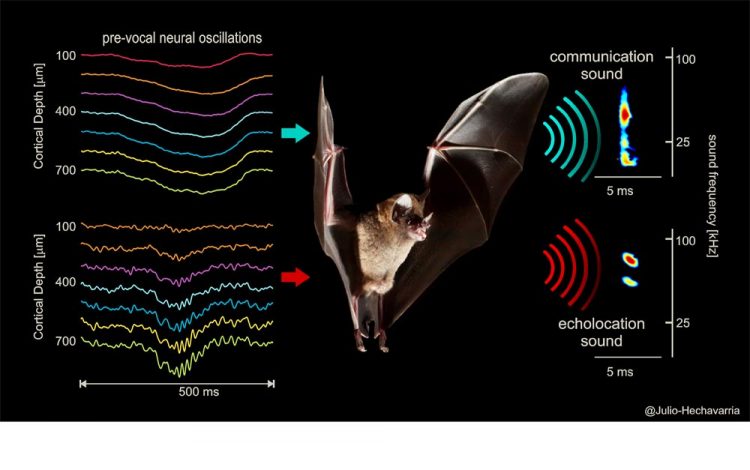How the brain controls the voice – Rhythmic neural signals determine the sounds that bats make

Different vocalization-related neural signals occurring across frontal cortex laminae (left) precede social calls (top) and echolocation calls (bottom)uttered by Carollia perspicillata. Julio C. Hechavarria, Goethe University Frankfurt
Bats are famous for their sonar-based navigation. They use their extremely sensitive hearing for orientation, emitting ultrasound noises and receiving an image of their surroundings based on the echo. Seba’s short-tailed bat (Carollia perspicillata), for example, finds the fruits that are its preferred food using this echolocation system.
At the same time, bats also use their voices in a somewhat deeper frequency range to communicate with other members of their species. Seba’s short-tailed bats employ a vocal range for this purpose that is otherwise only found among songbirds and humans. Like humans, they produce sound through the larynx.
Together with his team, neuroscientist Julio C. Hechavarria from the Institute for Cell Biology and Neuroscience at Goethe University investigated brain activity preceding vocalisation in Seba’s short-tailed bats.
The scientists were able to identify a group of nerve cells that create a circuitry from the frontal lobe to the corpus striatum in the interior of the brain.
When this neural circuit fires off rhythmic signals, the bat emits a vocalisation about half a second later. The type of rhythm seemed to determine whether the bats were about to utter echolocation or communication vocalisations.
Since it is nearly impossible to make a prediction within half a second, the Frankfurt researchers trained a computer to test their hypothesis: The computer analysed the recorded sounds and the neural rhythm separately and attempted to make prognoses using the various rhythms.
The result: in its predictions of echolocation versus communication vocalisations, the computer was correct about 80 percent of the time. Predictions were particularly accurate when considering signals from the frontal lobe, an area that in humans has been linked to action planning, among other functions.
The Frankfurt scientists argue that the rhythms they observed in the bat brain are similar to neural rhythms often recorded from the human scalp, and concluded that brain rhythms could be linked to sound production in mammals in general.
Julio Hechavarria: “For over 50 years, bats have served as an animal model for studying how the brain processes auditory stimuli and how human language develops. For the first time, we were able to show how distant brain regions in bats communicate with each other during vocalization. At the same time, we know that the corresponding brain networks are impaired in individuals who, for example, stutter as a result of Parkinson’s disease or emit involuntary noises due to Tourette syndrome. We therefore hope that by continuing to study vocal behaviour in bats, we can contribute to a better understanding of these human diseases.”
Julio C. Hechavarria, Ph.D., Auditory Computations Group (group leader), Institut of Cell Biology and Neuroscience, Goethe University Frankfurt, Phone +49 (0)69 798-42050, E-Mail: Hechavarria@bio.uni-frankfurt.de, https://www.julio-hechavarria.com/
Fronto-striatal oscillations predict vocal output in bats.
Kristin Weineck, Francisco García-Rosales, Julio C. Hechavarria; PLOS Biology DOI 10.1371/journal.pbio.3000658
https://journals.plos.org/plosbiology/article?id=10.1371/journal.pbio.3000658
Image download as tif file:
http://www.uni-frankfurt.de/86729013
Media Contact
All latest news from the category: Life Sciences and Chemistry
Articles and reports from the Life Sciences and chemistry area deal with applied and basic research into modern biology, chemistry and human medicine.
Valuable information can be found on a range of life sciences fields including bacteriology, biochemistry, bionics, bioinformatics, biophysics, biotechnology, genetics, geobotany, human biology, marine biology, microbiology, molecular biology, cellular biology, zoology, bioinorganic chemistry, microchemistry and environmental chemistry.
Newest articles

Bringing bio-inspired robots to life
Nebraska researcher Eric Markvicka gets NSF CAREER Award to pursue manufacture of novel materials for soft robotics and stretchable electronics. Engineers are increasingly eager to develop robots that mimic the…

Bella moths use poison to attract mates
Scientists are closer to finding out how. Pyrrolizidine alkaloids are as bitter and toxic as they are hard to pronounce. They’re produced by several different types of plants and are…

AI tool creates ‘synthetic’ images of cells
…for enhanced microscopy analysis. Observing individual cells through microscopes can reveal a range of important cell biological phenomena that frequently play a role in human diseases, but the process of…





















